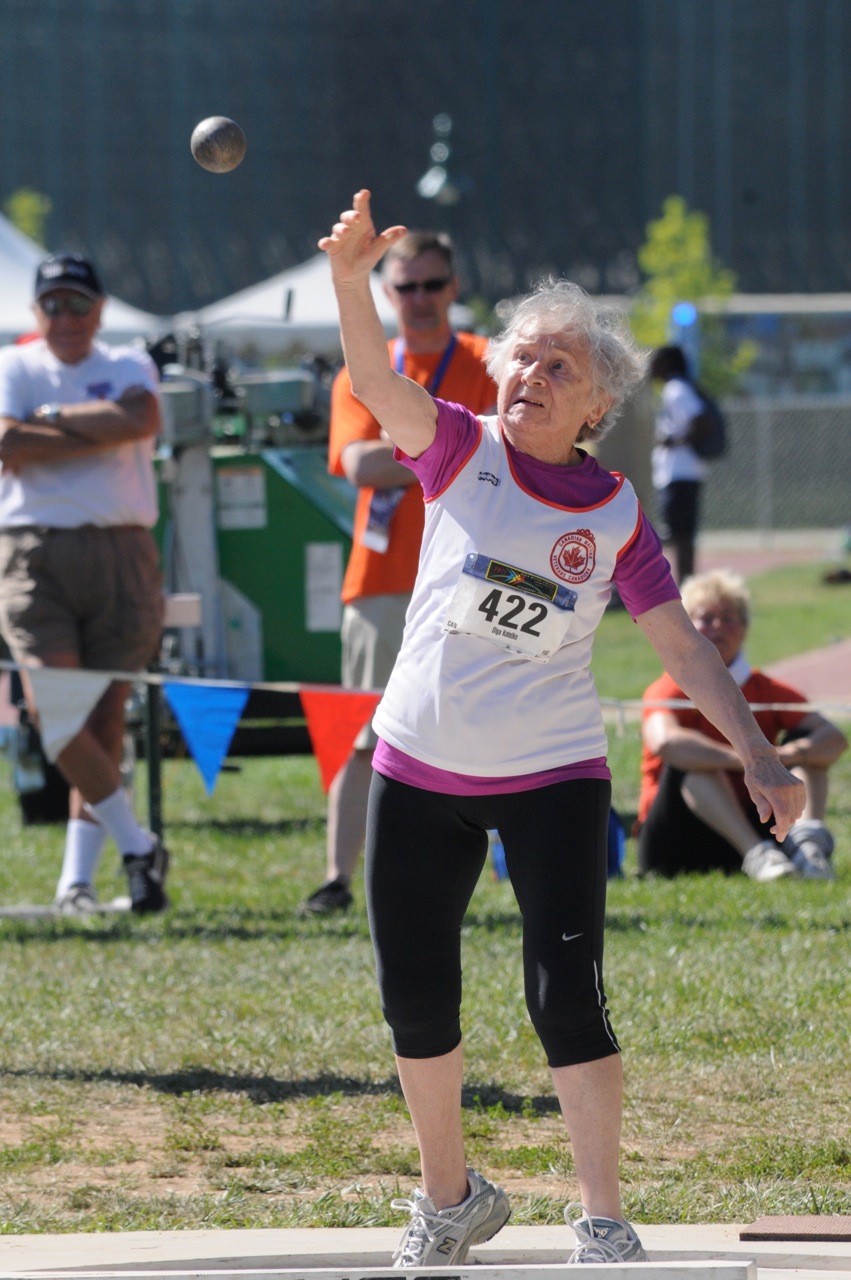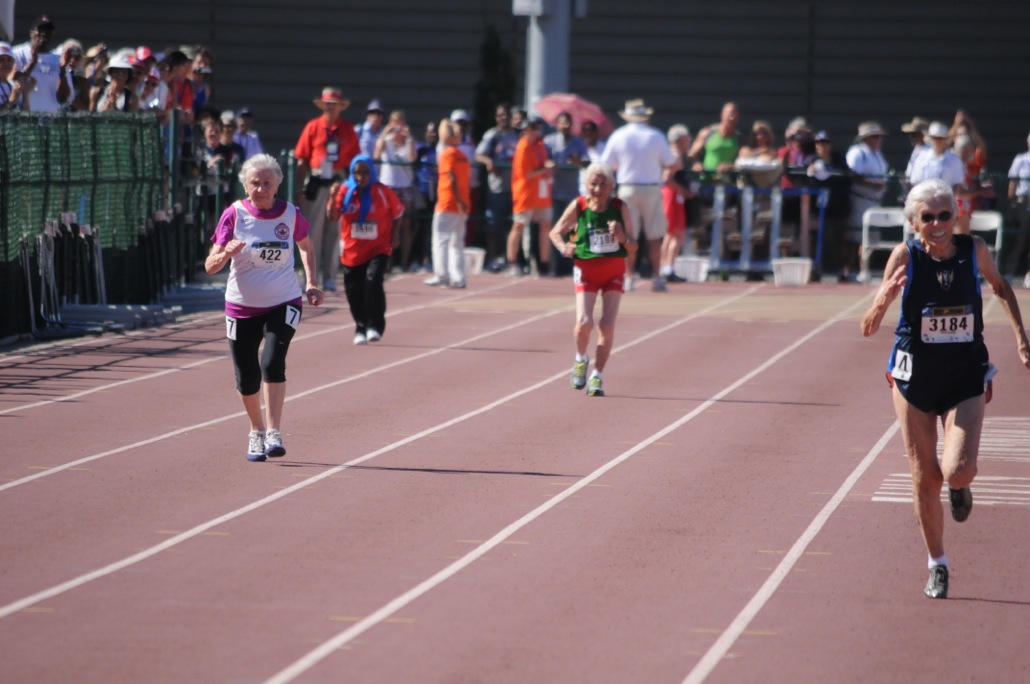Advertisement
What Makes Olga Run: The Full Scoop On The 94-Year-Old Track Star
“Most inspiring thing I’ve read in a long time,” I said happily to myself as I turned the last page of “What Makes Olga Run? The Mystery of the 90-Something Track Star and What She Can Teach Us About Living Longer, Happier Lives."

You may have caught author Bruce Grierson's 2010 profile of Olga Kotelko in the New York Times Magazine, and her appearance on On Point. (And she was just on "The Today Show," too.)
But Grierson's new book offers a much fuller look at the broader context — the science of aging, and exercise — and her own particulars, from her eating habits to her genes. I spoke with Bruce about the Olga Phenom and what it can teach us. Our conversation, edited:
How old is Olga, as we speak?
She's 94; she'll be 95 on March the 2nd, so that's a new category.
That's right, an even emptier age category in the Masters Track and Field events where she competes.
You've never seen anyone as excited about a birthday as she is about turning 95. What's cool about Master's Track is that they've framed it so you really do get excited about getting older, because it means you're closer to this next category, where competition is yet thinner and the chances of you winning a gold medal are yet better. So instead of dreading birthdays, everybody in this whole milieu is excited to grow older. It's pure genius.
The question of the title, "What Makes Olga Run," is certainly interesting — her motivation — but my biggest question is "How can Olga run? At an age when most people hobble?"
You mean, how is it possible that somebody seems to be staving off or forestalling the normal effects of aging? What everyone wonders is, can we be like that? How sui generis is this woman? And how unusual? And that leads to the question, is it all genetics? Because if it's all genetics, that's still cool, she's still interesting, but it doesn't mean as much to the rest of us if there's nothing we can do to be a little bit more like her.
The inspiring idea is to ask, 'Where are my opportunities to grow?' She asks that still, even in her mid-90s.
So we tried to investigate that, by doing genetic testing, to the extent you can do it, and just looking at her family history, that's a big one: If she comes from a long line of long-lived people and all her siblings are long-lived and her parents were, then you can start being quite confident that genes are driving the longevity part of this — but she doesn't. The rule of thumb is that longevity is two-thirds nurture and one-third nature - only a third of it is our genes and the rest is how we lived, and what we've been through, and our habits and our thoughts, and what we've done with the hand that we've been dealt.
Not to deny, though, she's got some lovely genetics at some level: Her hand-eye coordination is off the charts, as I discovered when we went golfing. And also the resilience that she's shown, being able to do all these different events and virtually never get injured, there's some sort of genetic protection there in addition to her good habits of stretching and being very alive to when she's taxing herself too much and backing off.
That was so interesting, this concept of "interoception," and how some people can just read the signals from their own bodies better than others.
You wonder, how can that faculty of being really, really attuned to our body signals be tested. I thought it was quite ingenious, the test that Bud Craig at the University of Arizona came up with: a good proxy of how much interoception we have is how well you can estimate the passage of time without a watch. Olga aced that test.
And she even fell down a flight of stairs and didn't get injured.
She fell down the stairs and she bounced. The doctors are puzzled because, as you'd expect in somebody that old, she's osteopenic, all her bones aren't really strong. But she didn't break anything falling down stairs head first. That was surprising to everybody. That could have just partly been luck but obviously there's some real resilience there.
For me, the inspirational effect stems from knowing that having a great old age depends two-thirds on how you live — and Olga didn't even get going on track and field until she was 77, and there she is, with a closet full of medals...
What I take away from that is: How cool, that she felt like there was still new stuff to do. It wasn't, 'Let's start folding our cards here.' It's 'What's a new thing I can do?' And also, it took her seven or eight years to get really good at track. She was pretty good right out of the gate, but it was in her mid-80s that she really went for it and got a really powerful training regime going. She got a trainer and she was in the gym for two to three hours most days. So it took her seven or eight years to hit her stride. And that's kind of what they say about anyone learning a new skill, it's supposed to take about that long.
And that made me think, 'Wow, OK, so that's eight years out of your life to become a new person and do a new thing and have this new life. What if we chopped our own lives up into eight-year segments, then we each get 10 lives. You could do something totally different every eight years and get really good at it...'
The inspiring idea is to ask, 'Where are my opportunities to grow?' She asks that still, even in her mid-90s: 'What are the opportunities here?' And I found that was so different from my attitude when we met. I found myself always saying 'Ah, I'm too old to fill-in-the-blank.' I was just kind of getting glum. Because I felt like there was stuff I couldn't do even in my mid-40s that I could do ten years earlier. So I was looking at the wrong side of the equation. And then I met Olga and she set me straight.
You're a very sympathetic character in the book, though, struggling with mid-life and sleep-deprived parenthood. How are you now?
I'm starting to rebound a little bit. I'm a little bit more pleasant to be around. If you asked my wife two years ago she would have said it wasn't so much fun to live with me because I was grumbly and moody and kind of in that weird sort of midlife-crisis-y way that people get.
And my health is better, just from some better habits. A lot of them are inspired by Olga — and just simple things like cleaning up my diet a bit and getting more sleep, and exercising differently. That was another thing I picked up from Olga: I was kind of doing it wrong, like so many of us. I ran these long slow runs, and I was getting too much LSD — long slow distance — and nothing else. All I had was that aerobic thing that we all made a fetish out of for so many years. And I had no other kind of health habits at all. I thought that one would be enough for carbon credits on all the other bad stuff I did, and it really isn't.
So now I don't go as far and I mix it up with some resistance training and weights and planks and the stuff that Olga has been doing all along, pretty intuitively. She was right.
Which avenues of the research you've explored have you found most intriguing?
One of them is the idea that movement — "un-sedentariness" — is more important than working out. We have to just stay moving. One of the big "aha's" for me was that my way for 30 years has been to get a workout in and then be inert, not think about my body, it's out of the way, I'm done, I got my chemicals balanced, I got my nice little buzz, I got my Ritalin, my body's sort of a plinth for my head for the rest of the day. And we're learning how terrible that is for you not to be moving for a length of time like that, in front of a screen.
So I think a bigger part of Olga's story is that she's been active for her whole life, not sitting, rather than that she's been training per se. It's the movement more than the exercise that's more part of her secret. Even just puttering is better than working out and sitting. You can't erase the negative of the sitting no matter how you work out.
It's funny how Olga does these things not because she's researched the science but because they feel right, and it turns out in a lot of cases she's right, the science backs up what she's just done just intuitively.
Olga sometimes seems like an amalgam of basically every single thing we know about healthy aging...
That's partly confirmation bias on my part as a writer, looking for things and then finding them in Olga. But you're right, so often I would find some little fact, like gee, you know what correlates well with longevity? Education. Well, wow, Olga's the most educated of her family, I wonder what part of the story that is? Or you find out that having a second language forestalls dementia by four years. Wow, and Olga happens to have a second language. I did find that a lot of the science did square with Olga, but she does do a lot of stuff right, my own methodological flaws notwithstanding.
And she's just having a great time.
That's one of the biggest things to me. She signed off an interview the other day, she was asked for her parting advice and she said, 'Laugh at yourself.' That is true. Just lighten up and have more fun and enjoy the moment — she's enjoying her moment right now incredibly, she's just relishing it.
Even the way we try to exercise, a lot of us, it's like being down in the mines, it's grim, the way we grind away on our machines or run. And she plays. She goes out and does things kids do in the school yard, they run and jump and throw things. She's an example of how to be fit while still having fun. It shouldn't be torturous. It should be what we're meant to do.
Readers, thoughts, questions, action plans? (And in case you're wondering why I spoke with Bruce Grierson instead of Olga herself, she's more of "an action figure," as he puts it; I figured that he's the super-verbal storyteller who delved into all the research.)
Special thanks to Ken Stone of masterstrack.com for photo permissions.

